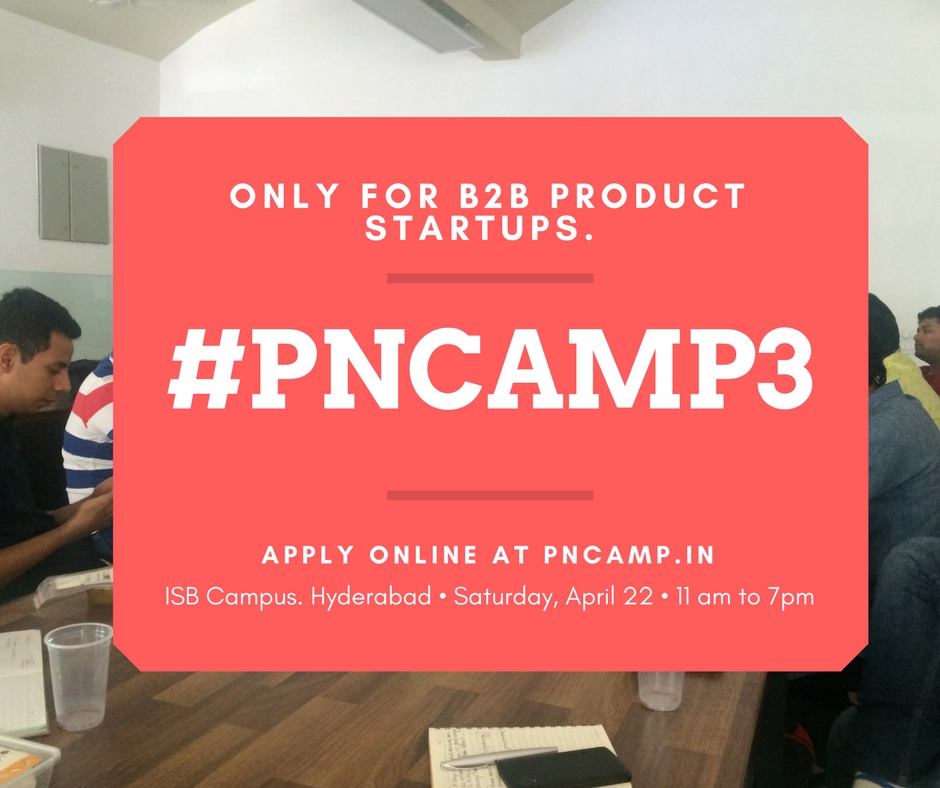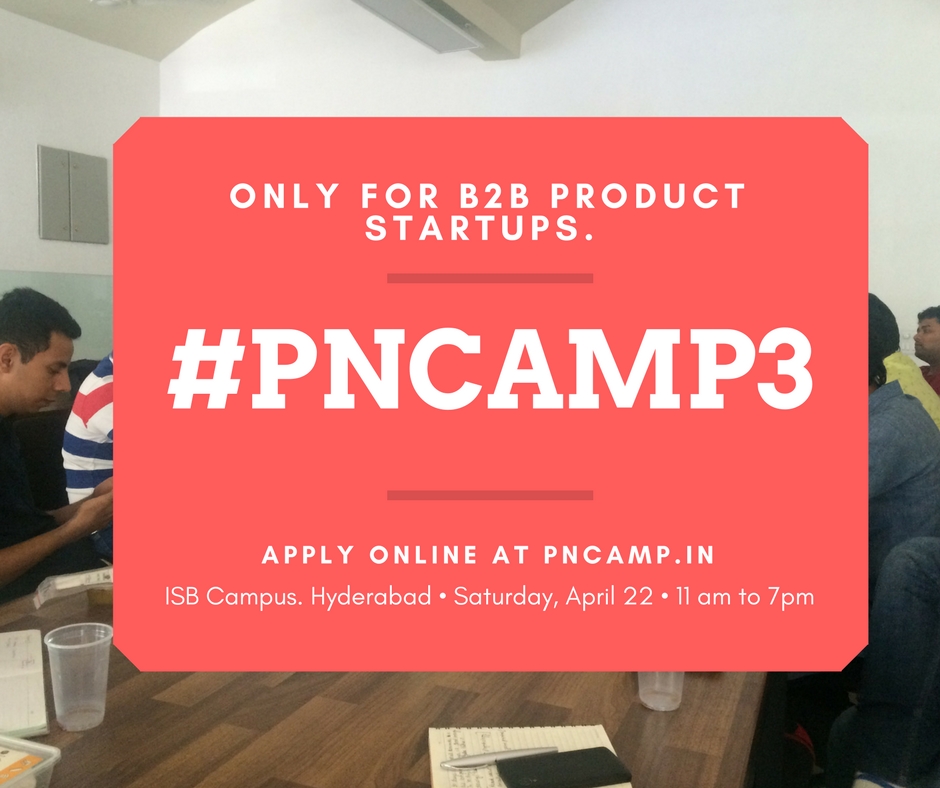Time to decode the ‘Social’ in ‘Social Commerce’
“If I had to guess, Social Commerce is the next area to really blow up” – Mark Zuckerberg
‘Social Commerce’ or more simply ‘Social Payments’ has been a relatively new concept to come up in the last few years. And in most cases, it remained like the early days of big data – easier to toss around but not presenting a clear picture. I believe the vagueness gets accentuated by the fact of the word ‘Social’ being a part of it. This is what leads a whole set of audience out there, to think that just latching on to or simply appending a ‘pay’ option inside a social network makes up for the concept. Nothing could be further from the truth. The true meaning of the word ‘Social’ in ‘Social Commerce’ is actually the full context of your real life use cases where any social activity is involved. For example – a dinner with your friends, an act of planning and sharing cost for a gift, so on & so forth.
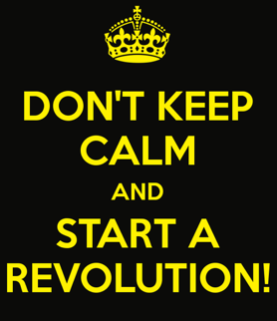 In fact, if you actually ponder, you would perceive that the real driver of this phenomenon has been something else entirely. It is the proliferation of ‘shared economy’ lifestyle that makes these social use cases so prominent and common for us. Also your payment instances and touch points intersect across the whole matrix of these use cases. Traditionally, the process has been pretty fragmented with the social & fun experience never coming across in those payments you made with your friends. Until now!
In fact, if you actually ponder, you would perceive that the real driver of this phenomenon has been something else entirely. It is the proliferation of ‘shared economy’ lifestyle that makes these social use cases so prominent and common for us. Also your payment instances and touch points intersect across the whole matrix of these use cases. Traditionally, the process has been pretty fragmented with the social & fun experience never coming across in those payments you made with your friends. Until now!
And the reasons are plentiful. Let’s start from why social commerce has not worked with the incumbents (your digital wallets) –
- The pain of uploading money first from your bank account (because come on, you don’t keep large amounts of money in your mobile wallet)
- The limits of sending money to another wallet (You can’t send more than Rs. 10k at one time as a normal user!)
- The charges and time delays on withdrawing my wallet balance into my bank account (They are charging you for transferring your money back to yourself!)
And I am sure you must have realized that the arrival of our own stack – UPI is the one of the key turn arounds (the ‘Paypal moment’) for Indian ecosystem, especially in terms of enabling ‘Social Payments’ as a category to exist independently in a big manner. UPI has brought about 10X the simplicity and 10X the speed which is a core pre-requisite for situations where you need to share money with your friends without any awkwardness. Now imagine adding all your social use cases on top of this beautiful and secure base of UPI. As you may have realized by now, that not only does it create a completely new paradigm but also increases the value by an order of magnitude (because of the network effects).
Once the wheels of motion start on any evolutionary path, it becomes almost impossible to stop them. The natural extension is that this category is bound to grow in India as well both in numbers and value (give the fact that it has already reached to 10s of billions of dollars in the west (US) with Venmo and the east (China) with WePay). The key thing to remember here is that in any new economy, it requires a fresh approach and outlook since the positioning is different from traditional P2P players and hence the product delivery and experience also needs to be different for the user. There have been numerous examples around the world with large social networks trying to add a basic P2P payments functionality and hoping it to take off in a big way. But it has not worked that well numerous examples like Snapcash (P2P payments via Snapchat in US).
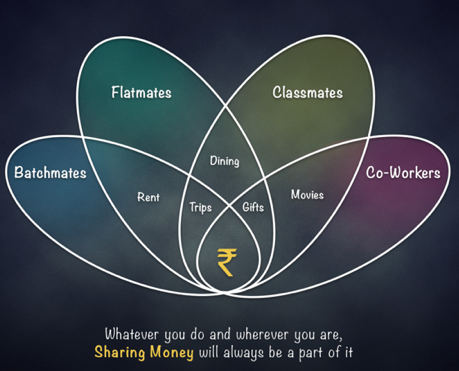 This brings us full circle to the two golden philosophies that have stood the test of time again and again –
This brings us full circle to the two golden philosophies that have stood the test of time again and again –
- The products that work on the premise of ‘this thing/activity can be done here too’ never make the cut. For example – ‘You can send money on Paypal too!’ is NOT what a Venmo user is thinking.
- Once a consumer associates a product with a certain repeat and high frequency use case, it becomes nearly impossible to change his habit and perception for that product. For example – Messenger has traditionally been a place for sending messages and that is what a user thinks of when he recalls that app (and not for sending money).
This is where the formidable advantage of having a clean slate comes in –
- Tailoring the product design around your real world habits when it comes to splitting, collecting, managing and tracking all your payments with your close contacts
- Ensuring that the experience is insanely fun so that it takes away all the awkwardness that traditionally accompanies any monetary transaction with your friends
- Ensuring that the product caters to all your use cases to such a minute detail that even you get surprised when it comes to the features!
Needless to say that I am more than excited about how the Indian market is evolving in the fin-tech domain (especially with the Indian government supporting it at an awesome level). Look forward to continued awesomeness and magic along the way.
Cheers, Rohit Taneja, Mypoolin
Creating a company brand — outside a product brand
One of the top two responsibilities of the CEO is to ensure that there is sufficient cash in the bank at all times. That often requires raising money from investors; an unpleasant task for most people! This article discusses a mindset change that is useful for fund raising.
The company by itself is a product that is best sold gradually and continuously to the investors — both public and private.
When we buy any product — say a mobile phone — we do so either because someone told us to or because our research led us to it. Even when we research a product, our view gets influenced by what we have heard about it. In the world of consumer goods, this is the power of the Brand. Raising money also relies a great deal on how the company is “perceived.” This perception is the company’s brand. The first round of money is largely driven by this brand perception. A lot of other aspects of the company (including fund raising in subsequent rounds) are affected by brand, as we will discuss in this article.
A company has two types of brands that coexist — the brand of the company and the brand of its product(s). Frequently the company’s brand gets forgotten or confused with that of the product. Yet, the company brand is omnipresent; created by the team, vision, past success, market opportunity, etc. For e.g. Nandan Nilekani’s next startup will have an immediate brand because of the team — well before the product has even been identified. As mentioned before, the first round is primarily driven by the company brand because there is nothing else.
The importance of company brand to fund raising often diminishes with time because delivered financial and operating metrics become the criterion for evaluating the company. When customers start using its product, the company’s brand gets pushed even further back because the overwhelming brand is that of its product. However this neglect is a wasted opportunity. In most companies there is no explicit recognition of the company’s brand and it has no identified owner. Given the criticality of the company brand for raising money, it’s imperative for the CEO to build that brand. CEOs who are very skilled at raising funds realize that they need to maintain the company brand in addition to the product brand. Consider for e.g. PayTM where Vijay has successfully navigated in and out of many businesses, while keeping the company brand associated with the promise of the future. Another example of the company brand being a driver is Theranos, the Palo Alto based Health Tech Company; of course the Theranos story did not end well because their brand was not backed by execution. However just that brand alone enabled Theranos to raise a fortune.
The Company Brand is not built in a day
Company brand building happens well in advance of fund raising and ideally never stops; the intensity just varies with time and circumstances. There are many ways to build the company brand in the early years of a company’s life.
- 1–1 engagement with investors to cultivate familiarity: set up periodic meetings with relevant investors to keep them updated, get their views, and build a relationship. These same people will talk about your company in forums and eventually people buy from people.
- PR — press appearances are noticed by investors (and by prospective employees, and customers). Its often hard to stay in the press for the right reasons so this has to be dealt with conservatively.
- Presence in forums — establish the position of a thought leader, be seen by peers in the correct context. These same peers will be used as references by future investors. So speak at events like the NASSCOM product forum or TIE.
- Key influencers in many areas; they can be cultivated as references or engaged as advisors
- Customer proxies — for e.g. head of HR of INFY if the product is to be sold to HR
- Product experts — for e.g. an advisor from Apple for a company that banks on usability
- Go-to-market experts — for e.g. someone from the sales team at Workday, for a SaaS company
A good company brand offers benefits that go beyond fund raising. It drives recruitment and retention (e.g. “best place to work”). It drives sales because customers often buy the company before they buy the product (e.g. the proverbial purchase from IBM). It drives policy/public acceptability (e.g. Google/Infosys wanting to be seen as doing good.)
Company brand building therefore needs to be owned explicitly — often by the CEO — and catered to as one of the critical outbound agenda items. By investing in the company brand from day one, the company’s odds of successful fund raising go up substantially.
Guest Post by Ashish Gupta, Helion Venture Capital
Capability -> Functionality -> Usability
The capability to build something – a product or a solution – is, but, just the start of things. Capability is needed to build a product but capability is not what gets your product to be loved by your (potential) customers.
One leverages capability to create a functionality (call it a feature, if you may). This functionality is created based on a broad understanding of the market needs e.g. one needs a mode of transport to go from one place to another. That is a broad market need. Based on this realisation, we set about building our solution. Depending on how one has understood the problem, the solution may result in producing a physical product like a new kind of cycle or a service, like a cab-hailing service.
 This can be called creating the functionality.
This can be called creating the functionality.
But this too is not enough. With functionality, one has expressed his/her understanding of the problem and to a great extent how one’s own perception has influenced the solution. When one goes a step further to get into the specifics of particular user needs (as compared with the broad market needs that I mentioned a bit earlier), then one starts to look at the usability or, as I prefer calling it, the usefulness of the solution.
To understand the user’s needs one needs a deep understanding of human behaviour itself. More specifically, one needs to observe and understand human behaviour in specific situations. So while one can build functionality based on a market need, to build usability, one needs to really observe and understand the user.
Being a keen observer, I notice multiple things and many times I find myself wondering at the thought that went behind creating that experience. An interesting example is this wash basin that I found at a major sports store.
Numerous times I have been a witness to a mis-aligned combination of tap, tap knob, wash basin and basin outlet. I am sure you too have. This one ranked among the top. The tap was actually hidden away. Did the person who put this thing together, have the capability? Yes! Did s/he understand the general market need? Yes! Did s/he really think about the user while building this? I would say, No? Or maybe, s/he did not care enough. But I am sure you get the point of usefulness.
In our own experience for the past 2 years, we have build multiple hi-tech features, cracking complex technical problems, patting ourselves on the back for being the geniuses that we are. But we realise that this is just a demonstration of our capability and what we can build from here is mere functionality until we get into the skin of the user. Of course, when I say user, each solution could have multiple, each with his/her own whims and fancies and hopefully a few common universal traits.
At RobusTest, on a daily basis, we try to bridge the gap between functionality and usability. Reminds me of something that I learnt in school about a variable tending toa value. In our case, on the number line between functionality and usability, we are striving towards usability – which is a constant goal but never completely reached.
The same should apply to any product/service and may well, be that small tweak that may get you that product/market fit that you seek.
Guest Post contributed by Aishwarya Mishra, Robustest
What’s the TAM Chasm?
How one entrepreneur’s mountain looks like a VC’s molehill
The apocryphal story of a newbie B2B founder, with deep domain knowledge, but no experience as an entrepreneur or in a startup. Note that while this example is not based on a single entrepreneur, it’s a composite to highlight the extremes.
Amita was a deep domain expert, with 15 years of experience in Wicro’s manufacturing services vertical. She identified a specific problem that a few of her customers had, costing them millions every year, which would get solved with a software product she dreamed about building. Being bitten by the entrepreneurial bug (her classmate founded FlipDeal), she decided to work together with a few old friends and colleagues, and start a business attacking the problem, with a couple of trusting old customers agreeing to do a paid pilot when she had the product ready.
As Amita and her team built the product, they initially used their own savings. Friends advised her to go to VCs, since this was exactly the kind of high-tech manufacturing software product that many VCs said they would fund. Amita was excited, she had seen FlipDeal raise a few Billion $, and felt that though her startup didn’t need as much, it would be good to raise a few million to hasten the pace.
The first VC meeting was a disaster, she was asked for their TAM (Total Addressable Market). And she was hardly able to define it well enough on the fly. The VC also said that manufacturing software was passe, IoT was the future.
“What’s my TAM?” she wondered on the ride back to the office.
“What’s our TAM?” the team asked her.
On the one hand, the specific problem they were solving was only for manufacturers in the auto ancillary business. This was a big sized market they thought, 60 odd large customers and a few hundred smaller ones spread over US, EU. The problem their product solved cost the large companies a few million dollars a year, and cost the smaller companies a hundred thousand dollars a year. Overall solving this problem would save the industry $300M. Of this, they estimated, they could charge $75M for the product.
The team was happy. There were few competitors and they felt they could become a good solid $25M business.
The next meeting with another VC was even worse than the first one.
“$75M TAM for an IoT product? For someone as experienced as you, and with the stellar team you’ve got, why are you taking so much risk — 8/10 startups fail you know — for such a small market?” advised the VC, running a $100M fund. “We will only fund you if you’re looking at a $1 billion market, and can make $100M annual revenue, otherwise the risk/reward doesn’t work out”.
Amita was baffled at how easily she and her team had been about to step into such a bad risk/reward tradeoff, even though they were smart, thorough professionals, who should have known better.
She decided to attack a much larger market, that was nearly the same as what they were trying to solve a problem for. Of course she didn’t know any customer in that area, but they were manufacturers too. Wouldn’t they have the same problems? No one in her team had done sales to the new segment, but how hard could it be to sell to a new vertical?
Back in the office, the team brainstormed the new market, $3 Billion wide, IoT for manufacturing across different verticals. Now the product roadmap had to change, since they needed to address different problems for different verticals, and they needed to make the product more generic. They had to drop some of the more intricate features for the auto-ancillary features too. That market was only a small drop in their overall bucket. So they obviously couldn’t do everything the small little market needed.
Miraculously the next VC agreed to fund Amita’s IoT product startup in a $3B market, and the team was now flush with cash, $2.5M to be exact. “Off to the races, let’s hire more people, build the product, get some more early customers” Amita thought.
But soon things weren’t rosy any more. Building the generic product that spanned multiple markets took much longer than expected.
Their early believers in the auto-ancillary turned sour, the product they were building was now not solving the specific point problem they had.
Their small initial pipeline ran dry, but they had a large pipeline of new prospects who they had never met before, who were all looking good to start engaging. But the sales cycles turned out to be much longer than expected outside of auto-ancillary. Perhaps the problem wasn’t as serious for others?
Their money was running out too, the $2.5M was designed to run for 18 months. Now at 12 months, staring at 6m of runway, with no product launched, no pilots won, and increasingly long sales cycles, Amita was at a loss.
Where had they gone wrong?
Wasn’t it supposed to be less risky to go after a large market?
Shouldn’t they get a great pipeline from the new sales guy they hired for a lot of $?
When their product built for a $75M TAM generated solid early paid pilots, why were they struggling to get any engagement in a $3B market?
Wasn’t it validation that they had a world class VC on board?
_________________
This is the story of some of the most capable founders with deep domain expertise, that I meet every month. While they have tons of deep experience, product ability, and network, it’s typically in a small specific domain, and not in a large, deep market.
In the process of building their startup, IF they move from small markets they know like the back of their palms, to large markets where they don’t know as much, the risk they are taking explodes.
On the other hand, if they are domain experts in the larger market, or end up creating a new large market, out of the small market they start in, then they have a great chance of building a true $1B+ business. Deep domain experts with 20+ yrs of expertise, selling and building for F500 — are best off hunting Whales, or Brontosaurus as Christoph Janz writes.
Typical VC fund economics
VCs with $100M funds need to return $300M to their investors. That’s the promise they make to their investors, 4X gross returns in 10 years as Fred Wilson shows, from a portfolio of top notch startups. And as Tomer Dean points out 95% of VCs fail to deliver sufficient returns to their investors!
So with 8/10 funded startups failing, a VC needs each startup in the portfolio to shoot for a $100M cash return to the fund. With a 20% ownership at exit, the startup must be worth $500M at exit, in 7–10 years from funding.
A startup seeking VC funds, therefore needs to rocket from $5M-$500M market cap in 10 years or less to be a success for a VC. To do this you have to build a $100M revenue business. This demands a market size well in excess of $1B.
At this return rate, the VC is ok if 90% of their startups fail the test, and fall short of returning $100M cash to the fund. That’s the risk/reward the VC is talking about.
At the other end, for a founder who has initial customers, has solved similar problems in the past, has a strong team, there’s actually little risk in making the first $1M revenue. Factor in a small market where no one else is solving the particular problem really well, they have little competition, and may win customers through referrals quickly. They have a good chance at building a $10M revenue startup, which might be valued at $40M.
Computing the risk/reward expected outcomes
In the VC model, going after a large market, the founders/employees end up owning 20% of the company at exit, with a 10% chance of getting there.
20% x $500M x 10% = $10M expected outcome.
In the bootstrapped model, going after a small market, the founders/employees own 80% at exit, with a 40% chance of getting there.
80% x $40M x 40% = $12.8M expected outcome.
Very similar expected outcomes, but very different risk profiles.
On the one hand, VC money is like strapping a nuclear fuel powered jet packon your back. When it works you get to orbit, but 8/10 times when you’re not ready for it, you’ll die.
On the other hand a longer slower more arduous climb up Mt. Everest, the rate of death is still high, but substantially more manageable risk wise.
Which path you choose as a founder, should depend on the size of the market you’re chasing, the cost of acquiring customers in that market, whether there are network effects that aid early movers, how much it will cost to build the product out to the quality the market demands, your own affordable loss, and more. And as Clement Vouillon says both paths are fine, but do know which path you’re on!
Too many founders are going to VCs with sub-scale markets (< $1B), and blaming them for not taking risks. A VC is NOT in the job of taking risks. They’re in job of building a high reward portfolio, and a small market can’t give a high enough reward.
Many founders think this is a one-time decision. Absolutely not! As Atlassian, Github and others have shown, it’s totally possible to bootstrap to find the right market-fit, and then take growth capital when you’re truly ready.
If you’re an early stage SaaS founder, and want to do this better, stay tuned for some hands-on assistance to grow past this choice.
Thanks to Manoj Menon for reading an early draft.
Smart tools for SaaS founders to handle inbound & outbound sales processes – #PlaybookRT94
When #iSPIRT announced a roundtable on ‘Building & Scaling Growth Teams for Saas Founders’ with Ashwin Ramesh (Synup) leading it, I was thrilled to join it, assuming it would be a direct take off from Ashwin’s session at #SaaSx4. Well, we were not disappointed. I am sure the other participants share my feelings on the outcome – It was an action-packed interactive session on the strategies one can use to be successful in SaaS.
Most fellow founders who joined the discussion chimed up with a common theme, with questions on how to get good inbound leads, how to scale up, crack the game, and most importantly – how to switch from outbound to inbound.
In this post, I want to provide a summary of all the tools that were discussed in the roundtable to help in content creation and distribution, and tools that will help you do outbound in a structured way. The sheer number of tools that we discussed was overwhelming to the group, to say the least.
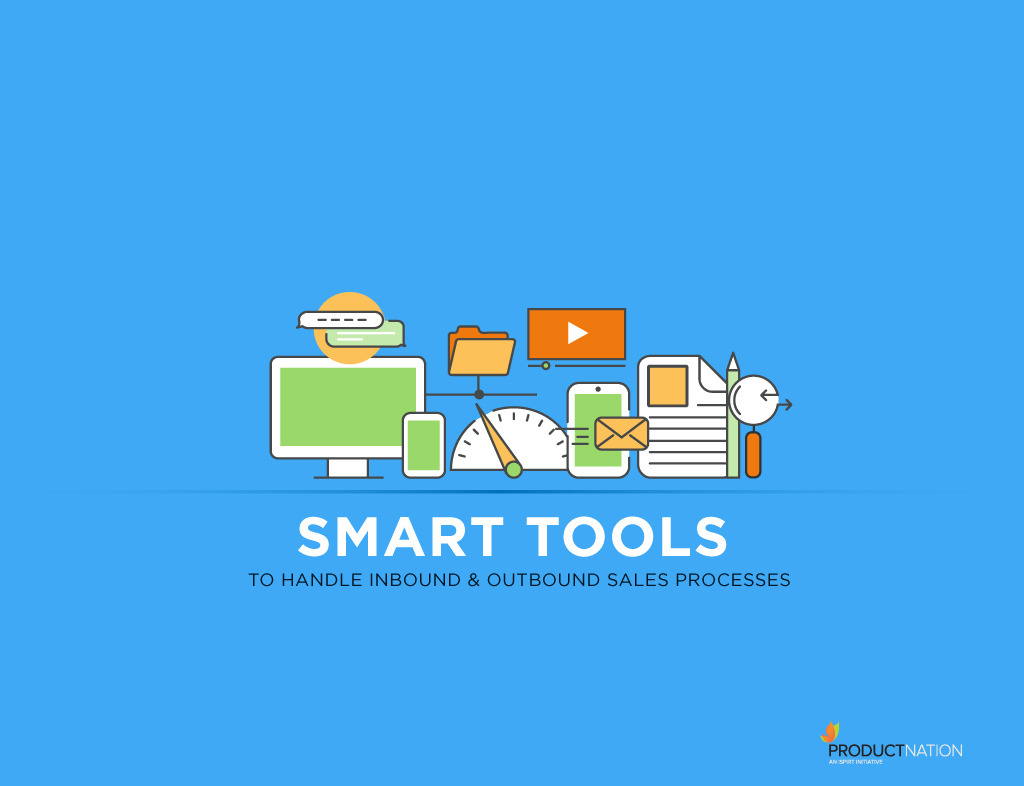 Content is still King, so let’s lead with it.
Content is still King, so let’s lead with it.
Content: Good content is more important than the fact that it is a blog or a post or guest post. It could be anything that attracts folks, and gives your product or service the attention span needed. Some of the examples of good content that were discussed include websites, checklists (e.g. http://localseochecklist.org/), videos, visualisations, infographics, data driven content, Quora ads, & Answers wiki.
If you need ideas on how to create great content, take a look at https://tympanus.net/codrops/.
Now that you have the content, let’s shift the focus to distribution. The traditional models of distribution have become saturated. No one’s going to come just because you wrote and published something. So you need to come up with innovative ways to distribute content. Well written content, if it is not reaching the intended audience, is a dead investment and one has to have deliberate policy of setting aside a budget, even if it’s a small one, for distribution of each piece of content. You should try the following options:
- Start contributing on reddit, and especially to a subreddit specific to your industry, business area or technology. The strategy suggested is to become active participants of a specific community, engage in discussions, post comments, contribute and build your credibility. The content you may share here would be actively promoted by other participants and also gets picked up other channels. The key is to build credibility and be supportive to other members.
- Another idea is to sign up to https://inbound.org/ and once again be an active participant, and a slowly become a regular contributor.
- A third option is to use services like QUUU to distribute or share content across social media including Twitter , Facebook.
- Investing in FB paid ads also has been found effective for many businesses.
- If you feel that the above strategy is high on investment and low on initial results, start using article syndication services like Outbrain or Taboola to engage your target audience while they are browsing or reading interesting content on the web.
- A good way to use Taboola or Outbrain would be to use it with Bombora, one of the best B2B intent engines. It gives you better options to identify / reach your B2B customers. There are integrations available for Bombora with Outbrain, and you need to decide on the budget.
- If you need to reach out to key influencers to help you share your content on a wider scale, use Buzzsumo to build the list and also get an idea about what your competition is sharing.
- Once you have the list, use Buzzstream to manage the outreach that is desired. It helps manage the relationships and also monitor the content sharing.
- One related area which may be of benefit is to reach out to journalists using tools like Haro and Bite Size PR.
- If you have good content, you can choose to distribute the same through newsletters. Look for a curated list of newsletter sites or owners and get your content into these newsletters. It is an ongoing challenge for newsletter publishers to get good content for their readers, so reaching out to provide them content becomes a win-win proposition
Social media is a powerful medium for reaching out to a wider audience. Tools that may be used for leveraging social media audience are:
- Lead Sift ( twitter ) – This is used to keep track of potential customer who are engaged by your competition . Helps in qualification of leads and setting up engagements faster
- EngageWise : To help present your content to a wider audience based on the interest they show in similar content. This helps in growing the pipeline using the reach of social media.
- Lead Feeder : Identifies the visitors to the website thereby qualifying the visitors and makes better / faster engagement possible. Offers and integration to CRM as well.
- Ad Espresso : One can create and test FB Ads in a very short time and run ad campaigns instead of single ads to effectively reach the different sections of audience thereby reducing cost and increasing efficacy of the ad.
Any website / online content strategy has to consider SEO. Some of the tools that can be used for SEO include ( apart from the tools offered by Google )
- Screaming Frog – This can be used for in-depth technical analysis on your site . It is a website crawler, works very fast & quickly allows one to analyse the results in real-time.
- All in one SEO : It can be used to optimize WordPress site for SEO.
Another key element of growth involves reaching out to prospective customers. For that , email is still the most effective mechanism. When it comes to using outbound emailing, getting good data ( email ids ) is equally important as the mail content and delivery strategy .
For Creating the Data ( emails ) the options available are
- Scrape websites for data
- Screaming frog : The custom extraction feature allows you to scrape any data from the HTML of a web page using CSS Path, XPath and regex
- Scrappy : An open source and collaborative framework for extracting the data you need from websites, in a fast, simple, yet extensible way.
- Some other common tools are
- Builtwith : One may get to see leads in your list by known technology spend, the usage or non-usage of competitor or other technologies as well as the usage or non-usage of entire categories of technologies like A/B Testing.
- Limeleads : Access to a large repository of business leads across multiple verticals
- Zoominfo : ZoomInfo’s Growth Acceleration Platform offers the most accurate and actionable B2B contact and company intelligence
- Buy data from publishers like D&B . This link is useful for Indian websites only.
Once you have the data , cleansing or cleaning up email list is the next key activity
- External agencies may be employed to clean up the email list. There are many service providers engaged in doing this for an acceptable consideration.
Once the email list has been curated, then you have to decide on the best way to engage the prospects or identify a delivery mechanism. There are many tools which support a structured approach to sending mails in a personalised manner, away from the mass mailers.
- Klenty : This is an outbound sales automation tool for your inside sales team to prospect, outreach and follow up at scale.
- Prospect : A simple tool for sales automation. Works well for cold emailing and drip marketing.
- Quickmail : Another simple tool to automate outbound emails.
- Outreach : Yet another platform that supports emailing and calling.
Any inbound process revolves around the sales funnel. Organisations constantly look for increasing the conversation across all stages of the funnel or improve the funnel itself. Some of the recommendations that came out of the extensive discussion included usage of Google Analytics and other exclusive tools for understanding the user’s journey in your website and app through session recordings, heat map analysis, etc. It would be good if cohorts are defined before initiating analysis so that patterns can be identified.
- Heap: Automatically captures every user action in your web or iOS app and lets you analyze it all retroactively.
- MixPanel: Follow the digital footprint of every user across mobile and web devices. Know precisely what happens inside your product.
- Inspectlet: Inspectlet records videos of your visitors as they use your site, allowing you to see everything they do.
- Hotjar: Can be used to understand user behaviour as it visually represents their clicks, taps and scrolling behavior on your website.
- Crazy Egg: Through Crazy Egg’s heat map and scroll map reports you can get an understanding of how your visitors engage with your website.
Other tools that were mentioned include marketing automation tools and A/B testing / multivariate testing tools. One common suggestion which came up was to use best in class tools rather than using all in one kind of tools. A few examples of specific tools are mentioned below. Since all of them are well known, I don’t think it’s necessary to add a description of what they do.
Marketing Automation tools / Communication tools:
A/B – MVT Tools
A big thanks to Ashwin and the roundtable participants for listing these tools and sharing their experiences in using them. I may have missed out one or two of the tools discussed. Look forward to your comments on these tools and also suggestion of other equally valuable tools for inbound / outbound processes.
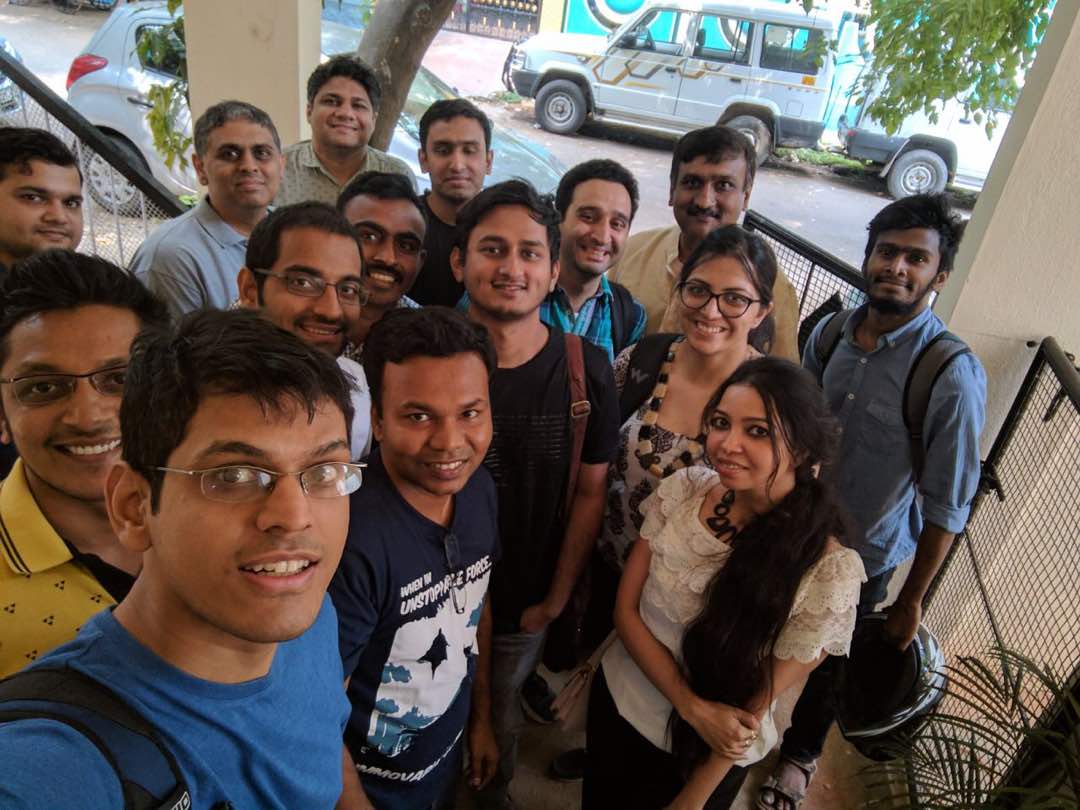 Disclosure : I am Neel Padmanabhan part of Team Lucep and head India Operations . Lucep is an instant response call back tool that is currently being used by several businesses around the world for handling inbound leads. The tool is designed to encourage visitors to the website to contact the sales team and get a response as quickly as possible.
Disclosure : I am Neel Padmanabhan part of Team Lucep and head India Operations . Lucep is an instant response call back tool that is currently being used by several businesses around the world for handling inbound leads. The tool is designed to encourage visitors to the website to contact the sales team and get a response as quickly as possible.
PNCamp#3 — Product Teardown UrbanPiper
Before writing something down about our experience at the recently held Product Nation Camp (PNCamp) product teardown session, I think it would be better to give a short perspective on the overall event from the viewpoint of a fairly reclusive startup in the B2B Saas space.
UrbanPiper has been around for some time; however, for a pretty long period, we haven’t taken part in any SaaS focused events. Well we did, but all of them were in Bangalore. The ones that we attended too, were mostly about networking with hundreds of people milling about and ready to deliver an elevator pitch if you so much as said “hello” to them. Nothing inherently wrong about such a gathering, but if networking isn’t your one-all-be-all purpose, these events stop making sense once you’ve attended one or two of them.
The PNCamp was suggested to us by one of our advisors. Not sure what to expect, the only reason we agreed to go was because we hadn’t attended any event for a decent length of time.
The event turned out to be a delightful experience — spread across a full day (Saturday), it was a small (80-100 people) gathering of focused individuals from a curated list of startups, with an evolved sense of SaaS business and products reflecting a matured outlook towards problem-solving. There was a team (including the founder) from the matured startup – Zenoti, which anchored most of the sessions and did all that they could to share their learning with the rest of us fledgling startups. The day’s events were well regulated to avoid any feeling of drag creeping in, and at all times, it felt like everyone was invested with a great deal of interest and purpose to contribute to each other’s box of learning.
The product teardown was the first session scheduled after a short inaugural talk by the PN team and the guest of honour – Mr. Jay Pullur (Founder of Pramati Technologies).
As it usually is with all things unprepared for, UrbanPiper was invited as the first startup to step up for the teardown. Not having any previous experience of a product teardown, I had no idea what good or bad was in store, and that in a strange way helped me calm down and focus upon telling the audience a good narrative about the UrbanPiper story.
THE TEARDOWN PROCESS
The teardown allows the speaker, a representative of the startup core team, to speak about their startup for 5-10 minutes. As part of the initial presentation, some basic questions are asked by any member of the audience. These questions are usually of the nature to understand a bit better about the proposition of the startup.
Once the presentation is through and the first wave of questions answered, the team from Zenoti takes over. They systematically explored aspects of the technology platform – the finished product, product interfaces, on-boarding process – but it all starts with the “deconstruction” of the website.
For us, the UrbanPiper website (https://urbanpiper.com) had been an effort to put up a decent web presence. Where “decent” merely meant that it was better as a façade than what our competitors had, and it somewhat managed to convey the platform’s proposition.
The following is what we felt manages to tick most of the checkboxes when it came to a Saas-based startup’s website:
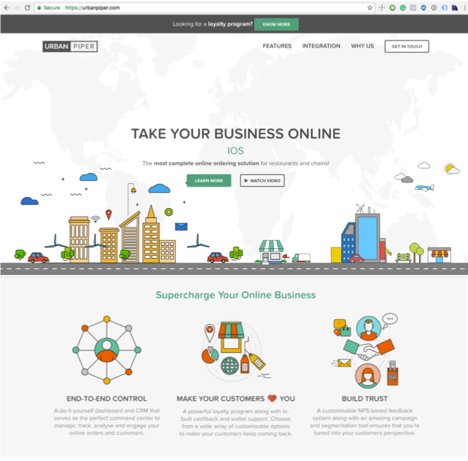
The next 15 minutes was a logical and well-executed act of unravelling the pointlessness of doing things half-baked and half-thought. While the focus was directed towards our website, but it didn’t take much effort to see signs of the same problems when it comes to setting a product vision, selling, pricing, negotiating, fund raising, marketing, etc.
The primary theme of the teardown can be summarized as:
- What have you built and how do you intend to sell it
- Does your website echo the thought-process expressed in #1
- The website teardown focuses on:
- The messaging around the primary proposition of your product/platform
- The explanation of how your target audience can use your platform
- The long-tail value of using your product/platform
- How has your platform made a difference for the merchants/clients who have been using it for quite some time
TAKEAWAYS
As ominous as a “teardown” sounds, the first thing to know is that it’s a very friendly event. Instead of feeling defensive about getting “exposed”, it is best to view the teardown as a get together of well-informed friends who point out the gaps in your plan to save you the blushes in the future. Think of the last time when a friend of yours pointed out that your fly is open – that probably best sums up the purpose of the teardown.
Another important aspect is the quality of feedback–you have some of the best minds, who have most certainly been-there-done-that, offering you their undivided attention so as to offer you advice which is best suited for you.
For us, the key takeaways boiled down to:
- Narrow down the area UrbanPiper wants to focus on. Instead of positioning the platform for every merchant, it would make it much easier to scale if we simply focused on being the best in one domain, and then decide to pursue another one.
- Overhaul the website to focus on simple messaging instead of using buzzwords, which would most likely make no sense to even the people you’d like to sell to.
- Break down the journey a merchant would have from not using our platform to the benefits of signing up and thereafter.
- Last, but certainly not the least, build out the product and the website with a focus on selling globally. This involves a change in setting out a more global plan, but the start needs to be with the website–which should reflect in no uncertain terms the intent to cater to a global audience.
CURRENT SITUATION
It’s been a week since the PNCamp, but we have already finished work on the first iteration of making some much needed changes to our website. This iteration is by no means a finished product, but it certainly embraces some of the direction that we should be taking with our platform’s positioning.
It gives me a lot of pleasure to unveil the new look of our website–
While this is just our first iteration, there are some key elements that we wanted to address:
- Focus the messaging around the domain that works for us.
- Take the visitor through various parts of the platform in a gradual and relevant manner – the features should unravel themselves as an easy to understand narrative.
- Use styling which gives the site a crisp look and feel, such as to measure up to the expectations of a global platform.
- Add a blog (https://urbanpiper.com/blog) section to write about the platform and make a visitor find out more. Not to mention, reap the benefits of better SEO.
- Prominently showcase a video which ideally has a current merchant talking about the platform.
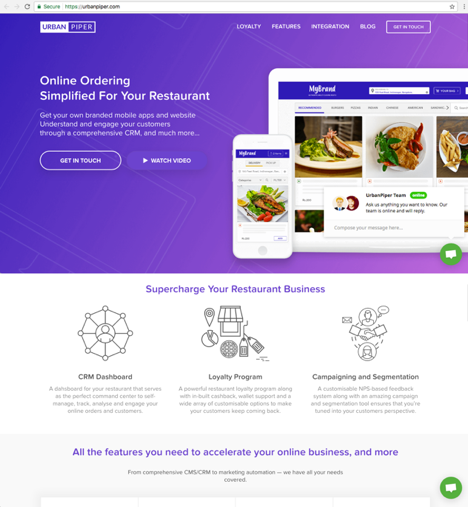
THE WAY FORWARD
We have just begun an interesting journey of making UrbanPiper relevant for the next phase of growth. During the PNCamp, Sudheer (founder of Zenoti) had suggested that I read a book – Crossing the chasm (Geoffrey Moore). I’ve just read the first chapter of the book, and already it feels like there’s going to be lots to learn from it.
Whatever be in store, it will surely help us rediscover ourselves at an important juncture of growth for UrbanPiper.
If I were to pause for a moment and reflect upon the events and the actions we’ve taken, it’s not like there was a grand revelation or something. Working in startups, we all carry a bunch of latent thoughts. However, in the everyday hectic operations of running a startup, we often lose “perspective”. If we’re lucky, then we have some good friends from other startups with whom we hang out regularly, and exchange notes, which in-turn helps us gain some of the lost “perspective”. But then, having friends from startups which have tread a path similar to yours, call for rather long odds.
Events are usually good to meet an eclectic group of individuals from the startup world, but then, most of them are primarily about networking, and soon lose value for all the effort that needs to be put in for attending them. And then, we just become lazy, letting our latent thoughts remain buried, while we continue to endure every aspect of a tunnel-vision syndrome.
For what it’s worth, the Product Nation Camp, was certainly a refreshing take on the idea of a startup conference – or rather, unconference. You’ve got a room full of smart people, doing smart things, and wanting to help you see things differently – to help you gain some of your lost perspective.
Guest Post by Anirban Majumdar @ urbanpiper.com
Customer Feedback: How To Collect And What To Do With It
Customer feedback is gradually becoming the cornerstone of growth initiatives.
A new research published in the Harvard Business Review found that the act of just asking for customer feedback in itself is enough to help keep customers satisfied and coming back for more — even when they do not respond to your request.
Several theories of consumer psychology point to the fact that even a simple satisfaction survey appeals to your customers’ desire to be coddled, reinforcing the positive feelings they might already have about your product, and making them more likely to buy from you.
The very process of asking questions or seeking opinions induces people to form judgments that otherwise wouldn’t occur to them. They might not consciously realize that they love a feature unless you seek feedback about it.

Customer feedback has become one of the primary drivers for long term growth. Present day organizations jump at every opportunity to talk to the customer or learn about them. Businesses are spending millions of dollars on setting up feedback channels: emails, reviews, surveys, website analytics.
The pertinent question now is: how do you utilize these channels to actually learn from the feedback? Before you establish the viability of a channel, it is crucial to develop a clear picture of WHY you are collecting feedback.
Are you seeking first-hand advice on product improvement? Are you building a new feature for which you’re seeking the users’ inputs? Have you been receiving a lot of complaints? Once you have the end goal clear, proceed to the tactical part: how do you collect feedback?
There is no one-size-fits-all tactic to gain information from your users. Different situations require different methods of collecting customer feedback. For example, a survey form sent to an already disgruntled user will only make matters worse; a phone call works better here.
Let’s find out what are the best methods of collecting customer feedback:
THE BEST WAYS TO COLLECT CUSTOMER FEEDBACK
There are hundreds of ways to collect feedback from customers. The ones we’ll talk about here are the most popular — they are the most effective too.
1. Long form-based surveys
These most common way of collecting customer feedback are survey forms with a set of questions that are usually sent in an email.
The one thing you have to always keep in mind here is to not get carried away and ask too many questions.
QuickTapSurvey states that the connection between the number of questions and the time spent answering each question is not linear. The more questions your survey has, the less time your respondents spend, on an average, answering each.
In other words, the more questions you ask your respondents, the more likely they will “speed” through it, and the quality and reliability of your data will suffer:

It is clear from the above table that the longer the survey, the less time will the respondents spend on each question. The takeaway is to make the survey as short as possible.
There is, however, no ‘ideal’ length for a survey. A few experts do say that anything between 5 and 10 questions is a decent number.
To keep your surveys short, a good rule of thumb to keep in mind is: only ask questions that fulfill your end goal. Ensure that every question serves a clear purpose. If you do not intend to use the information, do not ask that question. The aim is to collect customer feedback and not to have them write an essay.
For example: If you are surveying a customer who has just exited your paid plan, there is no point asking them if the onboarding was easy! Your only aim should be to understand why they are leaving and what can you do to prevent that.
It is also important to start with open-ended questions. Let your customers surprise you. Multiple choice questions will give you answers based on your own assumptions. If you really want to know what the customer is thinking, give them an open-ended question.
A great open-ended question is: What do you love the most about the product. It is also a great hook to have your respondents start the survey on a positive note.
When to use form-based surveys to collect customer feedback
The best place to use this is when we want detailed inputs and have some open-ended questions to ask. This should only be sent to an engaged user, who you’re sure would like to take the time to provide feedback to you.
One way we used this in Hiver was to understand from our users which integrations we should build. We asked customers open-ended questions about how they use Hiver. Then asked them which integration they’d like to see, which was an MCQ, followed by another open-ended question about how they’d like to put the integration to use.
2. Short in-app surveys
Customers are constantly thinking of ways your product can work better for them. Maybe parts of your app do not have what they are looking for, or maybe the design could look a little better, or maybe they found something that is broken.
More often than not, they will not reach out to you on your support address. That happens only when the problem is big. But for the minor lapses, your users will just give up and walk away slightly frustrated.
A great idea is to offer a survey while your customer is using your app. The survey can be prompted the moment a user has finished interacting with a particular feature in the app. Since the user is already in the process of using that feature, it is very likely that their feedback will be very precise and to the point, and not ambiguous.
Remember: Your users are on the app for a certain purpose, it is not a great idea to throw a long survey at them. Keep it to two to three questions that are relevant to the page that it’s being displayed on.
Intercom.io is a fantastic tool to trigger in-app surveys in your app. For example, the moment a user finishes using a particular feature, a quick question like the one below is a great way to get their ideas about improving it.
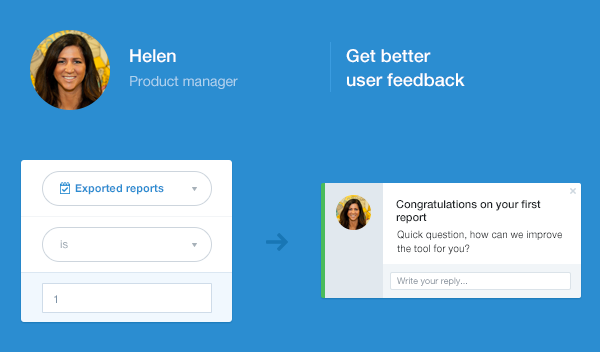
When to use In-app surveys to collect customer feedback
When you want a quick feedback from someone who has performed a certain action. Timing is of the essence here — you have to trigger the survey at the very moment a transaction ends.
The questions should be specific to what the user is using or has just used, and NOT about the product in general.
3. Phone calls
It’s said that if you truly want to understand someone, you will have to talk to them.
The surveys and tests will give you tons of data but they can never tell you what a person truly feels about your product. This is when you need to reach out to your users through the phone. It is a personalized and proactive method that generates the best responses.
Hearing a person’s voice and tone is the best way to sense what they actually feel about your product.
A call will help you tell the features that get users excited, features that really make their lives easier.
The key here is that the person calling the user should genuinely want to understand their problem and offer solutions. Do not do it because you have to do it. Do it because you care. This is not a sales call.
The second factor to keep in mind is the time when you call. Studies have shown that customers are more likely to respond between 8 am and 9 am, and between 4 pm and 5 pm. Lunchtime, between 1 pm and 2 pm is the absolute worst time to reach out to anyone.
When to use phone calls to collect customer feedback
Scheduling calls with your users, talking to them, and making sense of feedback which is not as structured as entries in a form is a lot of hard work. The key here is to focus on the users who can give you the best feedback to improve your product or service.
It makes sense to do phone calls only with the users who are avid users, have deep knowledge about the area you operate in and can give you actionable feedback.
This is not a good avenue when you want to reach out to a lot of people at the same time.
4. Transactional emails
Transactional emails are the ones that you receive right after signing up for a new service, or upgrading to a new plan, and so on. Basically, these are emails triggered by a certain interaction between the user and your app.
More often than not, transactional emails are treated like a necessary notice and companies would not put much effort in creating a dialogue with the customer. These emails often lack the aesthetic appeal of the website and the newsletters and deliver an inconsistent customer experience — that’s a shame.
Contrary to this popular practice, transactional emails can be used as a powerful weapon to foster a dialogue with customers. If we look at email open rates, these emails do better than all other emails, says an Experian report. The reason is that people actually want to receive these emails — for instance, they want to know if an upgrade went through or not. Asking the right feedback question in these emails will certainly get good responses.
Viking does a great job at it by asking users to rate their delivery right after they have delivered a product:
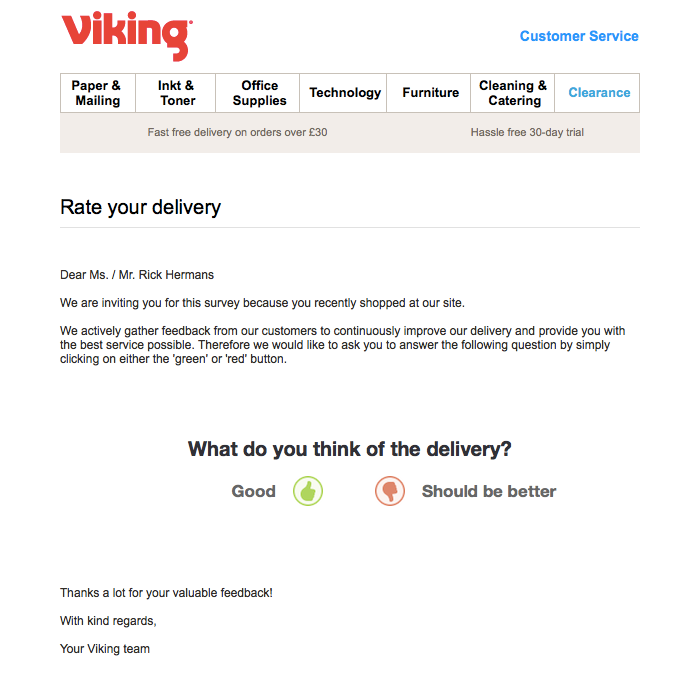
In situations when you do not have a question to ask, it’s a good idea to give your users a very easy way of getting in touch with you. Buffer does it neatly:

Interestingly, the peak-end rule states that ‘our memory of past experience does not correspond to an average level of positive or negative feelings but to the most extreme point and the end of the episode’.
Say a user receives a transactional email just after they’ve upgraded — asking a question at that juncture would evoke positive feelings about the product and set them on the path to loyalty.
When to use transactional emails to collect customer feedback
When a user does something significant: signs up, upgrades to or exits a plan, and so on. You can send them a quick one-liner question or a short multiple choice question. The key is to gain an insight at the right time without burdening them with too many questions.
5. Net Promoter Score Surveys
It’s the simplest question you can ask your customers: ‘’how likely are you to recommend us to a friend or colleague?’’ It is, basically, a method to measure your customers’ sentiment about your product.
People who rate you 0 through 6 are known as “Detractors”, those who rate you 7 or 8 are known as “Passives”, and those who give you a 9 or 10 are known as “Promoters”, as illustrated here:

Net Promoter Score (NPS) = Percent Promoters — Percent Detractors
Let’s take an example. Say there are 100 respondents.
10 responses were in the range 0 to 6 (Detractors)
40 responses were in the range 7 to 8 (Passives)
50 responses were in the range 9 to 10 (Promoters)
NPS: [(50/100)*100] minus [(10/100)*100] = 40
The worst score you can get is -100 and the best score you can get is +100.
Apple uses NPS surveys to find detractors and improve their retail store experience. Whether a customer made a purchase or scheduled an appointment to try on an Apple Watch, they e-mail a survey to rate the in-store experience.
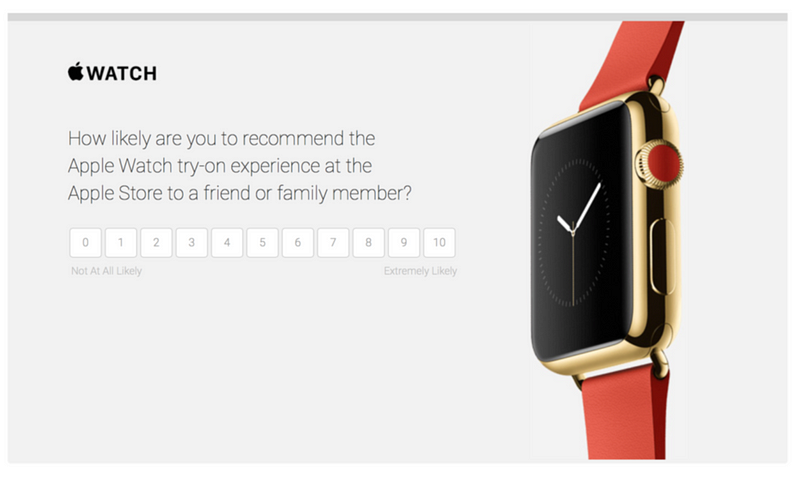
Remember: Any score above zero is good, anything above +50 is excellent, and over +70 is considered world-class.
The greatest advantage of NPS is its simplicity and ease of use. It can be set up in minutes and is easily understood by everyone in the organization. It also makes it very easy to compare yourself with the industry standards.
When to use NPS to collect customer feedback
When you want to understand the general sentiment of your users about a transaction. You can use NPS for any of the touchpoints that the customer might have with a team: sales, customer support, etc. For example, it is a good practice to send an NPS survey after a support query is resolved.
6. Suggestion boards
Suggestion boards take collecting feedback a notch up: it allows users to collaborate on ideas with not just the company, but also with other users.
These boards allow users to create feedback posts which can be upvoted or commented by other users. Top posts that have been upvoted or highly commented can help you discover what the majority of your users need.
The best thing about suggestion boards is that ideas that had been suggested by some customers became popular ideas among others who hadn’t thought of the benefits those ideas could bring.
Aha.io is a wonderful tool for creating these boards.
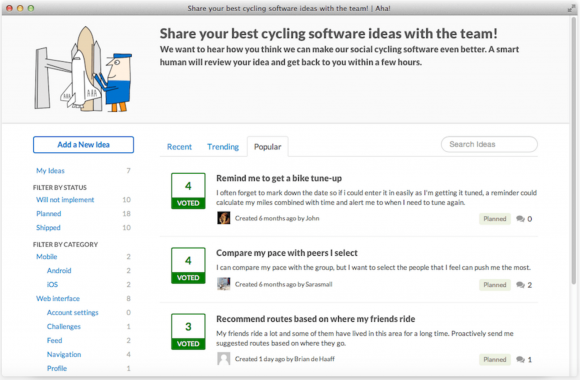
It is important to make the board very easy to navigate. Users should be able to add new posts with ease. Creating categories, allowing your customers to view the most popular ideas, and making it searchable are key.
Results will take some time to develop. Feedback will not be accumulated immediately. Wait till your users leave enough feedback so that you can determine which ones are popular to your entire base as a whole.
When to use suggestion boards to collect customer feedback
When you are looking for new ideas from your users. You should start with inviting the extensive users first — they know your product well and will be in a better position to suggest improvements or new features.
After you have a few ideas on the board, you can start inviting more users — they can upvote or comment others’ ideas even if they do not have one.
—
Once you’ve collected the feedback you want to pay attention to, the next step is to analyze the data and take actual steps to make things better for all stakeholders.
WHAT TO DO WITH THE FEEDBACK YOU’VE COLLECTED
“Every day, companies solicit feedback from customers, yet only a few translate that feedback into meaning. An even smaller fraction of companies actually take action or close the loop with the customer, to let them know their voice was heard,” says Whitney Wood, managing partner of the Phelon Group.
If you handle it right, the dialogue between you and your customers can become the biggest growth driver for your business.
The only way to reward your vocal and consultative customers is to roll with the punches and bring in actual changes.
Let’s talk about taking the feedback data to actual use:
1. Identify product improvement areas
More often than not, your loyal users would have developed an expertise of your product features; some of our users understand the product as much as our product managers do.
The standup product improvement meetings can only take you so far — the real insight comes from the ones who use your product regularly.
No matter how hard you try to empathize with them and put yourself in their shoes, your users will always have some exciting ideas that you did not think of.
So, stop brainstorming and start following the advice your customers give you. Not only will your customers appreciate your willingness to listen and implement their ideas, but you will set yourself apart from your competitors, as a business that genuinely cares.
LEGO Ideas is quite possibly one of the best examples of how customer insight can be used for product development. Enthusiasts can easily submit their own designs on this mini site. The projects gathering more than 10,000 votes from the community undergo LEGO review and are turned into new sets if the review is favorable.

2. Feed it into your product roadmap
Nobody understands the pain points of the product as well as the customers. If companies are able to incorporate customer feedback into the product roadmap successfully, they have certainly come very close to the ideal market-fit.
It is crucial to classify feedback into improvements and game changers. Let’s take a couple of examples from Hiver itself.
- A few of our customers thought shared labels can have different colors as that would help them manage their inboxes better. Now, this is a product improvement — we added it to our ‘task manager’ and had implemented in almost no time!
- After we built the shared mailbox, a few customers suggested we implement automation that will allow emails to be assigned based on a few pre-set conditions. Now, this is a game changer as it would significantly reduce the time people spend on task assignment. We added it to our ‘brainstorming session’ and discussed the pros and cons of doing it. It took us a few weeks to build it, but it’s been worth it.
The biggest challenge is to get your customers to suggest. Would they really bother to spend time suggesting a feature?
Fitbit implemented the suggestion boards and noticed that even the ones who did not have a suggestion were either upvoting and downvoting. Ideas suggested by other customers became popular among others who hadn’t thought of benefits those ideas could bring.

3. Find your niche
Most companies are not a hundred percent sure about the verticals they should focus on. It is never an exact science and companies end up spending huge amounts on trial and experimentation.
Customer feedback can be a good way to find out where you belong.
During the process of analyzing feedback from customers from a broad spectrum of verticals, you will begin to see patterns as to where do the majority of your happy customers come from.
Once you have discovered the verticals where the majority of your happy customers exist, start working on strengthening the relations you already have with them. Strive to make them your advocates and seek recommendations.
4. Prevent customer churn
Are you stuck with the principle that negative feedback should be swept under the rug and kept silent? It is a clear indication that you have set your customer success goal to a low ‘simply meeting customer expectations’. It is crucial to use feedback to improve customer service.
A customer who has taken the effort to call you is a lot more likely to tell their friend about the same problem — ignoring the negative feedback will have a compounding effect.
Contrary to what most businesses think, a negative feedback is an opportunity to prevent customer churn and foster a long-term relationship with the customer. These are the guys who’d need a little extra work: call them, understand their problem and ensure you do your best to make them happy. Ensure that you check on them regularly — make them feel ‘cared’. Showing that you care goes a long way in building a healthy business relationship.
By keeping the two-way conversation open and building trust gradually, you can turn these problem customers into raging evangelists.
Remember: they have taken the time out to give you a feedback when they could have just switched to another product. Any feedback is a display of interest in your product. Be wise and use feedback to improve customer service.
5. Discover potential advocates and nurture them
Customer satisfaction is the primary indicator of how happy they are with your product. Gathering feedback will help you quickly identify the happiest of your users.
The next step is to nurture them into advocates. Get them sufficiently excited to rave about your product and recommend it to friends and colleagues. Monetary rewards do not motivate advocates. Do simple things — thank you notes is a great idea.
HEX is one cool company that attributes a lot of their success to the handwritten notes they send to their customers.
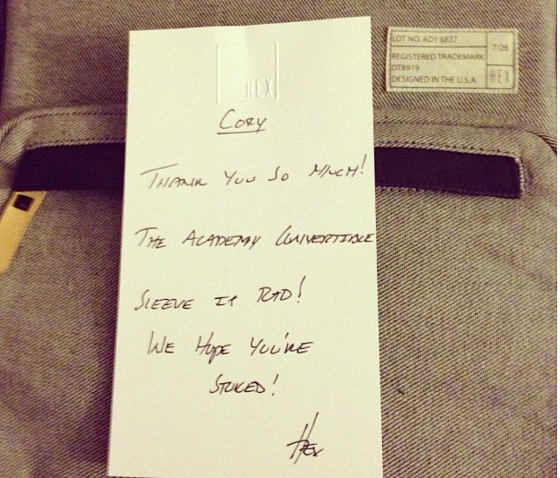
Here are some great ideas to turn your customers into advocates.
Imagine the world where most of your new customers came from business referrals. This can be achieved only when you know who your advocates are.
6. Motivate your team
Customer feedback can act as a secret driver to motivate employees.
Say you’ve been hearing praise about a feature — pass compliments directly to the person who built the feature, and ensure the team knows it too. It is a good way to encourage healthy competition among your team members.
Say you’ve been getting some brickbats about a certain feature — pass it to the person who built the feature and let them talk to the irate customer directly. It makes them feel in charge of that feature and they will be ready to take more ownership in the future.
Share conversations that are interesting and come up with new ideas about the product (improvements or game changers) with the whole team. It would help everyone understand the larger picture.
Wrapping Up: Feedback matters
A startling truth about most SaaS companies: your support team always understands more about what the customer needs than your product team.
It is time you start discussing your product roadmap with the support team as well — they are the ones who know about the ‘actual’ problems your customers face.
Building a good product and marketing it well is the job only half done. A lasting commitment to evangelizing a customer-centric culture, followed by a fierce commitment to gathering, analyzing, and sharing the feedback across the company plays a vital role in propelling your product and the business forward.
Always go back to your users and tell them you implemented something they suggested — this is a solid step in building a long term relation with them.
Originally published by Niraj Ranjan Rout at hiverhq.com on April 5, 2017.
The curious case of B2B SaaS Startup’s inside sales and marketing
Amazing but how? This question pops out of every startup founder’s mind while reading success stories. Persistence, determination & hard work, great to know, but nobody tells the real thing. Where are the techniques? With any magic, the logic behind is what a technician always looks for. So, where is the secret formula of startups having millions of dollars of revenue in SaaS?
‘XYZ’ startup got Series A $3M from ‘The one who every founder dreams of’ 10K Signups in a month (What were you doing? Tell me NOW!) $1M ARR in just 4 months of product launch (Who are these rich kids?)
These stories are highly inspiring, and to achieve such fabulous growth you need experience, the right product and perfect techniques of sales and marketing (Yes, funds could wait!). Being an early stage startup founder and that too into SaaS B2B, also an engineer who codes. I personally feel this is a deadly combination, where people like us know EVERYTHING when we start out BUILDING and half the way we realize about SELLING(hopefully we do!), the path to revenue, well the only reason we could be SUCCESSFUL.
The Invitation
While I was looking for my answers reading the book traction, building flows and learning by experimenting different traction channels, SaaSx happened (SaaSx was not like any other conferences or meetups, but really an experience to cherish, I now literally wait for the next one to happen) and there I met Avinash, he invited me to the PlayBook RoundTable Zero to One — Marketing and Inside Sales — SaaS happening in Delhi.
The invitation looked something like this..
Roundtable Focus Areas
– The PlayBook Roundtable will focus on how Early stage SaaS startups can get their first 10 and then the first 100 customers.
– The founders will share their experience of the initial steps to be taken, key metrics to focus on and the team structure for inside sales and marketing.
Facilitators
1. Sachin Bhatia (Ameyo/Inside Sales Box)
2. Ankit Oberoi(AdPushUp)
Bang On! it is very few times when you get the opportunity to hear from those who are just steps above you in the ladder, their learning from successes and failures could help you make the most out of your current situation.
Hops and Drops
11 founders at different stages of their startup journey in one round table conference hitting the bottom line with the right questions and right people to answer them.
- First 10 Customers, hacks to reach them? (Ankit’s hacks make you realize it is not that difficult)
- When to start marketing and help generate leads even before the product launch? (Conversations, Sachin even mentioned how first 100 conversations helped him get the Product Market fit)
- What is the actual Traffic / Conversion / Cost per lead from their experience? (These numbers helped to validate stuff you dream of)
- Initial Teams, Hiring Experiences and Compensation plans? (Most of us, funded or bootstrapped are struggling with this)
- Key learning in the initial lead generation and sales efforts?
- Content Marketing Strategy, to build for Google or Readers?
- Medium vs WordPress vs Your Own Blog? (It is not good for me to answer this here!)
- Launching product in the foreign market, the Hows of it? (SaaS businesses largely aim countries outside India)
- How to make your website the best marketing tool? (The number of leads generated from there, some mind boggling statistics we went through)
- To put pricing or not? (A million dollar question in itself)
- Hacks around Adwords and minimizing cost per click
- SEO, Keywords, On Page, the real metrics, and the lead generation techniques
- Tools to trigger drip marketing campaigns
- Social Platforms their reach and how to maximize with minimum efforts and cost
- The strategies worked for DIY tools
- Lead tracking, Website Chat
- Content — Blog / Ebooks / Video
- To go for PR or not?
- How to experiment more with current traction channels?
- Mistakes which led them to lose customers, and how reduce churn rate?
And much more.. A day full of insights, no presentations, no mind-boggling figures but real conversations based on the real fears we as founders and startups face everyday.
To not let go..
The journey of a founder has lots of ups and downs, engaging with the right people who could help you in a way you just imagined could be a path breaker.
Thanks a lot to the team at iSPIRT — Avinash and Rajat for making it accessible to the community.
Ankit and Sachin were as candid as they could be, the secrets of their business are going to help us take leaps with our startup.
Product Led Growth
The software product industry is swiftly graduating from desktop to cloud based applications. Interestingly, there is also a hand-in-hand shift in the associated sales and marketing strategy around these products. Till some time back, a typical B2B sales cycle was heavily dependent on building relationships, and hand-holding the prospects through the product implementation. In this new age however, the products are driving the sales and marketing by themselves.
Let’s define “Product Led Growth”. For this, let me ask you a question: What is common across all of the below products?
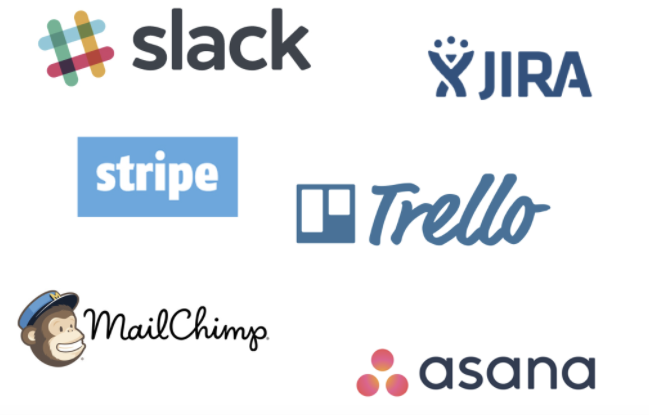
The answer: all of them are in the MULTI-million dollar club! All of them have demonstrated an exponential growth in business, and all of them are being used by millions of customers around the globe. And then, what else?
Well, its simple: all of them have minimal setup and minimal implementation time. Any person can simply go to the website of these products, and get him/herself started; all within a few minutes. All of these products offer a free trial and/or a freemium version: and it is exceptionally simple for anyone to start using these products. And this is exactly the definition of “Product Led Growth”.
“Implementing the product is faster than selling”
Jeff Lawson from Twilio (@ SaaStr ‘ 2017)
“Product Led Growth” is a concept where the product sells itself. Quick on-boarding of customers, and simplicity of the product become the reason for their exponential growth. There is no hand-holding of customers, and there is no requirement of any explicit sales effort.
It is important to get the customers to identify the ‘value’ of the product in the shortest amount of time. The product must show-case its most important feature (I like to call it the ‘aha’ moment of the product) in the least number of clicks and the least amount of time. Free Sign-Ups and Freemium packages are a very useful ways to achieve this goal. The ABSOLUTE best way to show a customer that the product solves his problem is by having the product to solve his problem. If the product is able to demonstrate ‘value’, then it’s easy to convert the customer into paid accounts.
“Self service is the core to our DNA; and the reason for our growth”
Mikkel Svane from ZenDesk (@ SaaStr ‘ 2017)
Let’s pick on the example of Slack:
(1) Free Sign-Up: Any person and/or organization can simply jump onto the Slack website, and get started. Getting Started does not involve any physical sales intervention and/or any payment formalities.
(2) Implementation Time: It takes less than 2 minutes to get yourself started! Slack provides an extremely simple, step-by-step process flow to receive the required information.
(3) Tutorial: What’s more, once you get into the product, you are welcomed by a SlackBot, and a series of screen overlays that tell you everything that you need to know to start using the product.
(4) Retention and Conversion: This is the best part – till 10,000 messages, Slack is Free. And by the time you exhaust your limit, you get so hooked-up to the product, that you feel good about paying for it!

More often that not, I come across a lot of startups in India, that struggle to hire expensive sales teams, even to reach out to retail customers. Right here, is a solution: there is much a lot to learn from the success stories from around the globe and identify the reasons for their success and growth. In essence, a product that is easy to use and simple to on-board can and will sell itself. With an initial kick and strong push from marketing, your products can quickly become their own self-sustaining entities. And once you have a self-sustaining entity, you can use the money that you’ve made to hire your sales teams, and focus on selling to enterprises.
Guest Post by Pranab Agarwal, Product Head @ RateGain & Co-Founder, ZipBoard.
If you are a B2B Product startup, here is how you can leverage #PNCamp3 #Hyderabad
iSPIRT brings #PNCamp3 to Hyderabad for the first time. There are clearly established trends that successful SaaS startups have started to emerge from India on the global front – with products that are world class and leaders in their categories. These are very early stages of a transition from a IT services world to a SaaS software economy.
#PNCamp for the first time in Hyderabad is a bootcamp never before presented to entrepreneurs in the region. It is a roll-up your sleeves kind of format wherein you will get to see real examples of companies which are analyzed. Very precise feedback on how to make adjustments to the company’s approach towards success are presented to the audience. This is all a part of the product teardown process – where other successful entrepreneurs help do such analysis for participating companies. Rather than hear boring talks – the format will be centered around addressing the issues that participants raise as key concerns.
There are three sessions where startups will present and get feedback.
Product teardown: In this section, select startups will provide a quick walkthrough of their product website. As each startup will get limited time to present, key is to stay focused on most critical or concerning area of your product. Experts and fellow participants will provide feedback on core functionality, usefulness, right fit of the product, visual and experiential aspect of the product. In the past, such product tear down has help entrepreneurs get amazing inputs in matter of minutes. Moreover it has opened up doors for more insightful beta users from the cohart. Product teardown session focuses on product flow, functionality, identifying specific KPIs and using analytics to derive insights, and immediate critical aspect that might be hindering product traction or stickiness. Founders will get actionable inputs that can be applied next day and see improvements. If you are interested to seek feedback, please apply here.
Idea to Launch (Unconference): The pre-launch phase is a very important phase in the development of your SaaS business and success in this phase can often accelerate growth once you launch to the public. Smart founders use this phase to understand as much as they can about who their ideal customers are, what their needs are and how much they would be willing to pay to get their problem solved. This session is in place to precisely discuss about this particular phase of your business.
Founders can learn from each other’s experiences in informal conversations on how to go about launching a product. Learn from the founders of Chargebee, Kissflow, Zenoti and many other SaaS founders on how they went about their product launch. From market sizing, validation, identifying lead generation channels to feature prioritization, learn it all from real stories
“What makes a good pitch deck”: One of the most important(if not the most important) resource your startup should spend time on is the pitch deck. Your pitch deck is the window to your startup. The way your pitch deck is structured can make or break your fund raising plans.
What should you include in your pitch deck? Should it be too long? Or too short?
How can you estimate the market size?
What are the key metrics investors look for in a pitch deck?
All these questions and more will be answered in this session. In this session we will do a pitch teardown of two selected startups. Investors from LetsVenture and successful startup founders who have raised money will analyze the pitches and suggest what works and what does not. They will give you pointers on how to calculate the key metrics and how to continue tracking them.
This session is a must for startups who are looking to fund raise.
The entire bootcamp comes together due to the energy infused by Founders who purely volunteer their time towards the cause of helping companies succeed. Successful entrepreneurs like Suresh of KiSSFLOW, Krish from ChargeBee participate in these forums purely with the desire to see a vibrant ecosystem of SaaS companies.
Look forward to seeing you all for what will be the most hands-on bootcamp ever made available to entrepreneurs in Hyderabad.
This is a MUST attend camp for any early stage product startup. Do not miss this unique opportunity to catch the brains of experts and fellow participants through product feedbacks and interactions. So, if you are an early stage startup looking to take your startup to next orbit, then register yourself right away at www.pncamp.in Lets build great product nation, one product at a time! See you at PNCamp.
Guest Post by Sudheer(Zenoti), Chaitanya(Ozonetel) & Laxman(AppVirality)
Enterprise Sales — 101
Recently, Jyothi Bansal published an extremely interesting post titled “Science of Enterprise Software Sales”, where he writes about the journey and the process behind building a world class sales organization. Its a must read for anyone in sales, even more so if run an enterprise software company.
This post is targeted at the enterprise sales rep, based on my 13+ years of enterprise sales experience.
I’ve had the privilege of being the first sales hire at a couple of startups so far in my life [ I was the first sales hire at Capillarytech prior to Qubole ] and have worked with some of the best people in the business. Having spent over 10+ years in enterprise SaaS sales, I wanted to put down my thoughts on what an individual sales rep could do to become successful.
This post is mostly my reflection as the first enterprise sales rep for the APAC market for Qubole, and to set expectations for many others who want to take a jump from being a sales professional at an established company into the startup world. Also, if you are part of a startup sales team but remote, this post can help you prioritise and focus on efforts that can help you become successful.
For someone who wants to get into sales — you might want to check my earlier post on how Sales can be a great life Skill.
Additionally, this could also help help first time founders to help identify the right kind of first sales hire who could potentially become a great sales leader for the company.
Setting Expectations — The founders are typically the first sales people in the company, but once they have a reasonable set of customers (about 20 in my opinion), it’s time to Hire a dedicated person who can step it up and focus on sales only.
Be Hungry: Don’t be foolish.
Don’t expect Spoon feeding. Understand everything about the business.
Unlike large companies, where there is a dedicated plan for Onboarding, early stage companies cannot afford that luxury. In startups, there is no spoon feeding, don’t expect your boss or anyone else come to you to give you info that you need. One needs to be proactive and must know how to get information that will help you make yourself successful.
When I joined Qubole, I had very little knowledge about the Bigdata landscape but thanks to the brilliant engineers at Qubole and spending countless hours in asking questions, I was able to understand the product, underlying technology and also articulate, why anyone with large amounts of data on the cloud should care about Qubole.
Being the first sales hire, you don’t start with a playbook, you have to build a playbook that works for yourself.You have to close very fast, very frequently. You can only do that if you have answers to all the below questions.
1. Identifying the key personas of people who have the pain point
2. Quantify the pain point or the benefit
3. Create need
4. Create urgency
Small consistent steps, leads to big changes in your pipeline.
In my opinion, the best sales professionals have three things in common
1. They are great listeners
2. They are curious and always ask the right kind of questions.
3. They are Disciplined
When you are part of a remote sales team and you are on your own, you don’t have the luxury of learning from your peers or distributing work to other functions.The best way to learn how to sell is by selling.
Unless you are out in the field and talking to prospects and customers, you can never start. Cold calling / emailing is an effective way to gauge how well prepared you are. Sending emails that get you a response is an art and you will get there only after going through the pain.
Protip: writing emails that get noticed.
i. Be Personal and convey why that person should care.
ii. Asking a question usually helps, it brings a certain amount of authencity in wanting to understand more about how they solve a “particular problem” people have in similar industries
iii. Highlight the single most important thing your company is known for and why you should care.
iv. Always talk about low bar to enter, highlight potential risks of non action.
Doing this consistently, I was able to build a pipeline and the next part was to create opportunities from interest.
Un-qualify
The larger the pipeline, the better right. Partly correct. A better way to build is to narrow down the criterion for a prospective customer so you can focus on. While its important to go wide in the quest of an opportunity, its even more important to ask enough to weed out the ones where there is no opportunity for that quarter.
As much as qualification is an important process, quick Unqualificaton is even more important.
At Qubole — We had 5 questions that we asked in the first call that helped us identify whether or not there was an opportunity. The 5 questions helped us qualify the lead (incoming or self created) — It also saved enormous amount of time for us at events / conferences. Yes, to all questions meant that the opportunity was super-hot.
Qubole platform is used by Data Scientists, Data Analysts and Engineers and allowed people with no skills in Bigdata to implement Bigdata in production. It democratized access to data which in English means — Qubole allowed Analysts (with only SQL skill sets) to write queries against massive amounts of data, which was earlier possible only if you invested heavily in building a bigdata platform in-house or via a vendor.
Try before you buy — Always have a well-defined Proof of Concept / Paid Pilot to make it easy for your customer to decide, but make sure you are in control of the PoC.
It’s very important to define.
i. Expected outcome of the PoC (what is termed as success or failure).
ii. Expected outcome in what timeline.
iii. Who are responsible to sign off for the expected outcome in that timeline?
iv. Assuming it goes well — what is the next step? Who need to be involved and what does it take for that process to happen in parallel ( eg: Legal review, security review
We had 100% closure rate from this step onwards.
Again, highlighting the importance of Unqualificaton as it allowed us to spend enough time on the ones where the probability of closing was a lot higher.
The Close
Your job is not done until the signed document and money in the bank. Right from your first cold email to your followups to the PoC, this is what you have been waiting for.
What’s the cost of getting a Bigdata project into production 3 months earlier than their original date?
This helped us to close the deal as soon as the PoC was done. Keeping a pay as you go model meant that customers always realize the value before they pay –Which was completely opposite for competition.
Pro Tip — De-Risk the deal from the people.
If your talking to only one person in the company and the success of the deal depends on this one person (even if the person is the CEO), the deal at risk.
Get multiple people who are critical for the success of the project (project = deal to be signed) involved. Never talk to just one person in the company.
If you are doing a PoC, get the contracts vetted by the prospects legal team for identifying potential red-lines, you don’t want this to start after the PoC is done. Most legal teams take 7–10 days to get back and they don’t care about your Month end or a Quarter end quotas.
Bad News Early — One of the things I learnt very well and learnt the hard way was to convey Bad news early in the cycle. This allowed me to set expectations with my management well and seek help when people can actually help and not at the last minute when nobody can help you even if they wanted to.
This is not an exhaustive list but a few things that helped me, to hit my numbers quarter on quarter in a completely new market, where we did not have a brand name, where we had to work on creating the need and urgency.
Quit to start again.
After laying the foundation for Qubole Sales outside of US and building a million dollar business under 15 months, I quit to start Fyle along with my longtime friend and co-worker at Qubole, Siva Narayanan.
Its also a great feeling when your former boss blesses your new venture by being an angel.
Thanks Joydeep Sen Sarma, Marcy Campbell, Ashish Thusoo for an incredible opportunity !
Guest Post by Yashwanth Madhusudan, Fyle.
Why #SaaSx4 Product Teardown is for all SaaS startups
Whether you’re an early stage, late stage or VC funded startup (pun intended). There is one thing all of us struggle with always and that is ‘Growth’. So, how to keep this repeatable in constantly changing market dynamics?
Acommunity is a great place to learn, unlearn and grow at the pace you never imagined. For SaaS startups in India(bravery award goes to you), SaaSx is a community built by thought leaders for other builders to nail this process in and out. #SaaSx4 was a tech event that provided SaaS founders the opportunity to network and share product insights with other SaaS founders.
How we got into #SaaSx4 Product Teardown..
Widely is an early stage SaaS startup, we’re right now hustling, learning and trying to respond to the amazing traction we’re receiving. While all this was happening, we got a call from Prasanna K to attend SaaSx, that was the first time we heard about Product Teardown and horror stories around it. Imagine your product being grilled down to levels in front of the whole community.
It did seem scary, but we said YES!
Because very often when something scares you, it’s the very thing worth doing.
So, what were our asks?
Initially they were simple, to validate our thought process, marketing channels, and product roadmap, but subsequent calls and discussions with Avlesh Singh, CEO, WebEngage, Bharath Balasubramanian, Director of Design, Freshdesk, and Shekhar Kirani, Accel Partners, made us realize it is an opportunity to deep dive and their critical remarks made us rethink over pricing to customer onboarding.
#SaaSx4 Event Day: The D-Day
This was my first SaaSx & by the end of the day, I was left amused and happy to become part of the SaaSx community. It is by SaaS founders for SaaS founders, hence, the learning becomes easier & straight cut out for us.
UnConference, Product teardown & Fireside chats, also in between meeting Investors (trust me that was not the driving force for anyone joining in there), the energy was to learn and grasp as much as possible. When you hear guys like Girish, Sudhir, & Avlesh talking about their mistakes, you feel confident within.
There comes the Scary Product Teardown
So, how it began?
I was called on the stage, Bharath, Avlesh and Shekhar ready with their inputs. The hall was full of awesome SaaS founders, including those of India’s best SaaS companies, interacting constantly over the good and bad parts of products(Imagine receiving suggestions from the experienced).

- Introduction: I went up and gave some context to the audience
Widely helps online businesses to acquire new mobile users, increase conversions and grow user retention with nothing but their existing website by upgrading it into a progressive web app in minutes. Introducing native mobile app features into a website, the plug and play setup with the analytics based dashboard to trigger and customize a Progressive Web App (Mobile Web App).
- Product teardown segments & Widely’s State
Product teardown was segmented into three sections primarily, Finding Customers, Keeping Customers & What is my market.
- Widely’s primary traction channels are SEM and SEO,
- Also, our customer segment is a marketer or a product manager.
- For us to convert a website visitor into a customer is a simple 2 step process, a signup and then 15 minutes plug & play integration into their website.
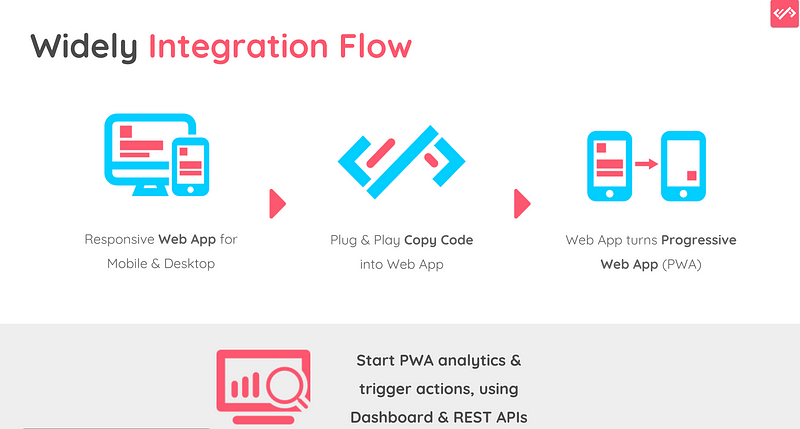
These details were used in teardown, and so teardown was designed in a way to be helpful for others struggling in the similar space.
- The Teardown began
As an early stage startup with a goal to reach the global audience, we’ve identified search and ads as great ways to go ahead. So, exactly this was the first step, Widely’s SEM at one side works great, SEO is where our keywords don’t match. That was eye opening to me as sometimes while building and selling the product we tend to forget most basic things.
Then came product landing, with few ifs and buts, here we saw our moments of wows & learning, in the form of better representation.

Bharath pointed out key areas we need to improve upon during Sign up too, although this is something we’re constantly working upon and rigorously followed making website our best marketing person, but exactly the point, improvements to become sticky for the set of next 100 customers should be the focus.

The final step to Setup!
So, out of all signups we get every day there are many who don’t integrate (A huge loss to our marketing efforts), there could be many reasons, we’re constantly using visualizations and website conversion optimization tools to see where our funnel breaks and fix those parts immediately. For us to come at something which we saw next would have taken some next 100 signups we believe,


The next step of teardown focused on our claim of no coding required, though that is not required but looking at the setup it feels a coder is required, and for us targeting product managers this doesn’t look related at all.
Suggestions by Bharath for the setup screen
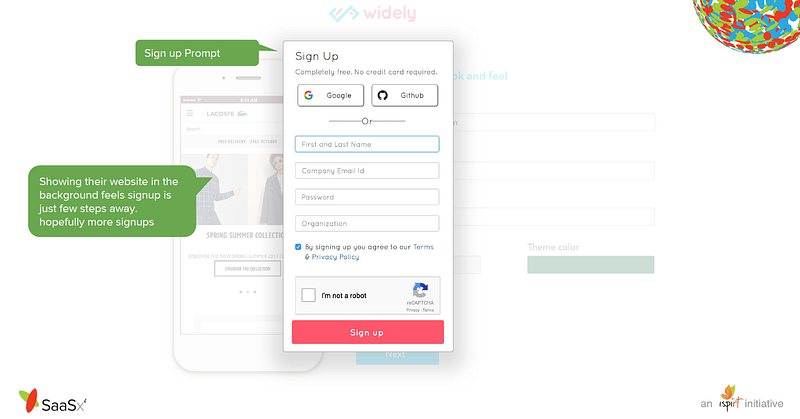
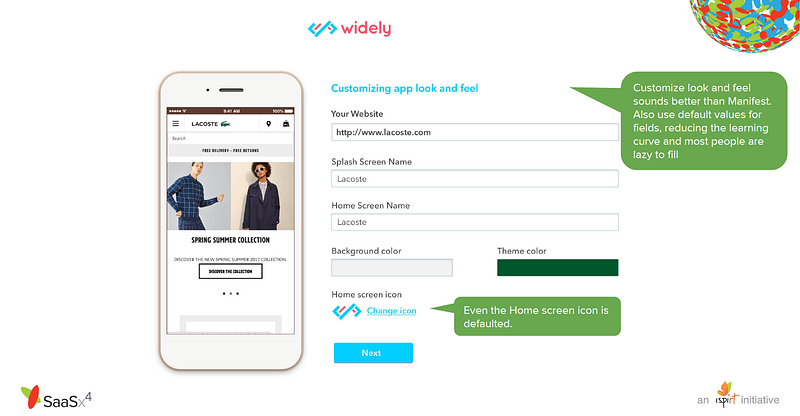
The designs in themselves speak louder than words and hence, something we loved instantly, apart from great design and user experience inputs. We got great insights from,
Girish — Website landing page heading should initially focus on technicalities, then functionalities and later on the larger message when the brand is big enough.
Ex: Coca-Cola — open happiness.
Ex: We say ‘Upgrade into a Progressive Web App’, this is good for us initially as an early stage startup, segmented only for the crowd who knows.
Shekhar — Asking telephone numbers from our initial customers is a great way to increase conversions rapidly, our signup should have that one field.
The last but not the least, Product Positioning and Market
All the above insights make no sense when we don’t know our market. I did talk about the positioning of early stage startups and how we did it for widely.
As there is this increasing need of brands to be accessible by all mobile users, we get queries from enterprises, brands, services/agencies related to our solution, we’ve been on and off on where to focus and what we should leave. This also made us change our pricing many times.
The last part of teardown was a relief when the founders sitting there, Shekhar & Avlesh made us believe you don’t need to stay at one, until you get where the best market is. All this made sense, as then we could generate higher revenue by understanding our value add to the users.
At the same time, we received Girish’s point of view on growing freemium way and onboard as many users as we can,
So here is the beauty of SaaSx, you get everything, now it is going to be a tough fight within the team to choose a way.
Key takeaways..
An enthralling experience in Widely’s product journey, SaaSx, and product teardown happened to be extremely helpful. In my opinion, teardown is a great way to eliminate blockers and move faster against competition and changing market.
I’d like to end by a note I sent out to Avlesh, Shekhar, Bharat & Avinash.

Definitely I’m in awe and I’d like to mention Product Teardown of Omnify & Product Teardown of 99Tests, these were our fellow product teardown startups, they have explained the process extensively to explore further. Hope it helps more SaaS startups growing and hustling.
Team 99tests At #SaaSx4 Product Teardown
#SaaSx4 is a leading tech event that provides Saas founders the opportunity to network and share product insights. Product Teardown session was one of the key highlights of this year’s event held in Chennai on 17th March, 2017. The goal was to help SaaS entrepreneurs gain actionable product insights. Entries were invited from innovative SaaS products from all over the country.
When we, at 99tests got the first email invite for the Product Teardown from iSPIRT, our first thought was that, this was about UX and we might not be a good fit for the event. We then had a conversation with Prasanna who explained to us that product tear down is about Business Discovery of our Product and retention of customers. Basically, a session that will enable to understand your product from a customer’s perspective. This piqued our interest in the #SaaSx4
Wonderful event with lot of take aways. Kudos to team @Product_Nation ! #SaaSx4 pic.twitter.com/y44gWIr8Yl
— Rani Paruchuri (@RaniParuchuri) March 17, 2017
A panel of established SaaS founders and mentors that included Avlesh Singh, CEO, WebEngage, Bharath Balasubramanian, Director of Design, Freshdesk, and Shekhar Kirani, Accel Partners, were assigned the task of selecting the final products for the event. The first screening call with the panel was very interesting. It was a 30 minute call where we got the chance to showcase what 99tests does, and how it works. We answered questions about revenue, SaaS model, our core value proposition, and how we delivered our services.
With only three slots left, the pressure was on us as we waited for the results. After a few days, we finally got the message that 99tests was selected in the SaaSx4 Product Teardown. We were pretty excited and looking forward to all feedback on our product from eminent members of the Indian startup ecosystem. We admit that we were also a little nervous that our mistakes would be out in the open!
Key Takeaways From The Event
Software products chosen for the product tear down session were critically analysed by a team of expert SaaS mentors and SaaS founders. The aim was to understand the customer onboarding process, retention and discovery of business opportunities for the products. These insights helps entrepreneurs in answering key market questions like:
- Who is my customer?
- Who could have been my customer?
- What characteristics of my customer makes them like my product?
- If I am successful, who will come after me?
Our Experience At The Product Teardown
In the next call that we had a call with Bharath, Director of design, Freshdesk, we explained how 99tests actually works. The key questions were around customer on-boarding, understanding how much of our service was self-serve and how much was fully managed.
On D-day, we were a little nervous, wondering what aspect of our product would be showcased to a room full of SaaS founders. The first teardown by the first team did give us a hint into what would come next.
What We Learnt About Our Product
The first part of the teardown was about seeing how the search keywords map to our target personas. It was good to see one of the teardown companies having website that perfectly matched the keywords that they were targeting. In our case, we learnt that on our page, the content did not contain enough matching keywords that a customer would type in. This makes it difficult for them to find us.
The next feedback was on our homepage. We found that it was using too much of testing concepts. Moreover the Home page did not clearly highlight the functional message of Automation Testing by Crowd, our USP.
The last set of feedback was on customer on boarding. Here, we learned that our product asked too many questions that assumed that our customers would know a lot about testing. This is causing a lower sign up to the demo page. It was also great to learn that we needed focus in terms of countries, based on how customers would perceive our product. The most useful feedback that we got, is that product owners were not clear on how much time they needed to spend with 99tests on a daily and weekly basis. although they could get started in only 30 minutes.
Overall, we got the feedback, that we do have a fantastic product, but the messaging was not yet sophisticated enough for an international audience and could be improved. 99tests is very thankful to iSpirit, Bharath from Freshdesk, Avlesh from WebEngage and Shekar from Accel for the opportunity to be a part of the Product Teardown at SaaSx4. The feedback and insights we gained from the SaaSx4 Product Teardown was very helpful in identifying areas that needed improvement and also in gaining new ideas to make our products great.
Guest Post by Praveen Singh, 99tests.com
Deep And Wide Product Adoption Are Key To Reducing SaaS Churn
Who am I writing for? SaaS product managers and founders.
We recently had someone move on from Wingify (the company that owns VWO and Pushcrew). After they were gone, admin was doing a review of our software expenses and found a line-item for Popcorn Metrics with no clear owner. The person who had left was the only one using it, and no one knew why, or what it was used for.
Removing Popcorn is as easy as removing a code snippet, so I reached out to them asking to cancel.
This is the problem when your product hasn’t been adopted widely or deeply. You might have sold the product in that a customer is paying for it, but you haven’t truly sold it until they’re using it extensively.
Width
By width, I mean that multiple hierarchies across departments in a company are using the product. Best examples would be:
- communication platforms (Skype, Gmail)
- HR & performance management software
- document editing and management (Google Docs, Office 365)
If a product solves the basic needs of any workforce, it’s likely to be adopted widely. The more widely a product is used, the more value it’s providing and consequently, it’s difficult to remove.
Depth
By depth, I mean the level of dependence on a product. For me, defining features of deep adoption are:
- the product supports a key process, eg. the company’s sales process runs on a CRM, performance & payroll management is done on an HR software, or technical support delivered through support software
- the product has important data that companies don’t want to lose
- the product enables, or connects with multiple other data silos to make 1 + 1 = 3
- the product is mouldable to support the company’s workflow
Placing the products we use at VWO on a depth/width graph, here’s what I came up with:
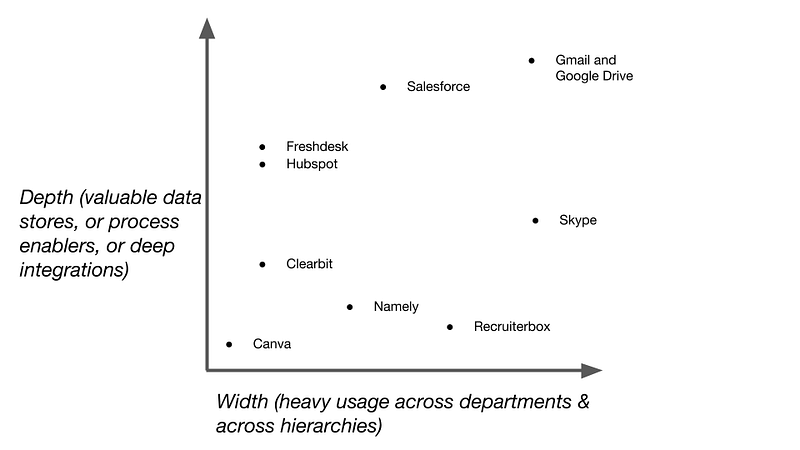
Explaining the graph above:
- Recruiterbox comes in the middle-ish because it’s mostly used by hiring managers and HR. It is used across all departments, but not across enough hierarchies. And the data it contains isn’t as valuable… mostly resumes/profiles of candidates who weren’t a fit.
- Canva, the easy graphic design software for non-designers, which I put to show a product that has minimal width or depth. It mostly comes up when designers aren’t available. Going by Canva’s initial positioning, they might get slightly deeper adoption if they are able to tap into social media marketing teams.
- Clearbit, connected to Salesforce and used for lead enrichment. We hardly ever login to the product, but I suspect we’ll keep using it until the contract renewal date rolls by and they raise prices. That’s when we’ll probably look to BuiltWith or something similar. I’ve included Clearbit to show a product that takes care of a small but important part of a business process, and as long as it does its job and the business process remains the same, it’ll keep being used.
- I’ve put Namely in the middle because even though it is HR and performance management software, at Wingify we haven’t adopted it fully. I notice that everyone uses it, but only for a few days every quarter during appraisal time. It could have deeper adoption if we had big-company kinda HR processes, but since we don’t, maybe Namely is suited to big companies with more sophisticated HR policies and management?
- Salesforce is probably the best example of a product completely owning a process, owning data, deep integrations and being used extensively by executives. I admire them for this, though I will never recommend them to anyone because of the painful experience it is dealing with the company and the product.
More thoughts
Not all products can have wide and deep adoption, but that doesn’t mean all hope is lost. If a product can capture even one important process for a team, the likelihood of churn reduces significantly. For example, Canva could if it targeted teams that need quick, good-looking images without relying on a graphic designer. First thing comes to my mind is social media teams in B2C businesses who are running campaigns all the time. Or take Recruiterbox from above, not widely or deeply adopted in the org but does a damn good job of streamlining the recruiting process.
Products tend to have higher a lifetime if they have some of the following properties:
- Are the “source of truth” in an org for important process/data
- Are in the core departments of finance, HR, sales, manufacturing/production/product and R&D
- Are used by practitioners and executives for different purposes
- Some or all parts of a team’s KPIs are reported by the product
- Are heavily used by senior management
- They are close to the value provided & realized by a company, like product, R&D or revenue/profits
Salespeople are trained to hack the selling process by reaching the highest decision maker as soon as possible. No doubt this still works, but in a world where hierarchies are flattening, practitioners who’re going to be actually using the product are becoming important factors in the buying process. Making a quick sale without adequate follow-up support from customer success managers leaves you at a risk of being upended after the contract period.
The Customer Success function can have a massive impact on increasing lifetime value if they understand that their goal in the first few months is to increase width and depth of adoption of the product, and they’re incentivized towards those goals.
Based off my Canva point, I realize that when you’re creating a product, it’s important to think of the process and data that you’re going to own, and for the teams + hierarchies that you’re going to own them. And this needs product + human effort.
I’m surprised why products don’t integrate more deeply with email. There’s this entire hullabaloo about AI and chatbots right now (early 2017). I’d instead focus energies on much a deeper sync with Gmail and Outlook. After all, that’s where the majority of decision makers spend their time.
Guest Post by Siddharth Deswal, Lead Marketing at VWO. This post originally appeared on http://deswal.org/saas/to-reduce-churn-your-saas-needs-to-be-adopted-widely-and-deeply/



